Introduction to Ratios & Proportional Relationships Transcript
GFX:
Tch
TeachingChannel
Lower third:
Enumclaw Middle School
Enumclaw, Washington
+++ 00:00:06 +++
Student: I get what you were saying, but I think we should do three sticks of ten red and then two sticks of ten blue.
Chrystal Morey: I set no limitations on their thinking. By knowing what students actually know I can better dictate where the future lessons need to go.
GFX:
Illustrative Mathematics:
Introduction to Ratios
& Proportional Relationships,
Sixth Grade
+++ 00:00:26 +++
Chrystal Morey: So welcome, you guys. We can see up front that we have our target for today.
GFX:
Lesson Target
I can create a model that shows how two values compare to one another.
Chrystal Morey: Today we’re gonna be working on creating a model that shows how two values compare to one another. Today we get the opportunity of trying to create the perfect color of purple paint. Okay, in fact, I’d like to paint our room. So purple is a better color. And, look! Just for the task I wore purple today.
Lower third:
Chrystal Morey
Middle School Math Teacher
Enumclaw Middle School,
Enumclaw, WA
+++ 00:00:51 +++
Chrystal Morey: In the sixth grade lesson today I introduced the idea of ratios and proportions. And we’re trying to just help them to understand a comparison of amounts and how they would scale that comparison.
Chrystal Morey: Perfect purple paint is made by taking two cups of blue paint-- okay? And putting it together. And taking three cups of red paint and putting it together. That makes one batch of perfect purple paint.
+++ 00:01:19 +++
Chrystal Morey: Our sixth grade glass had never before been introduced to the concept of ratios and surely not a part-part and then whole concept. They might have looked at two different numbers and how they’re connected. So their concept the were looking at was simply how are they scaling numbers. We were looking at the difference of additive versus multiplicative thinking.
Chrystal Morey: For the first five minutes you have some blocks on your table groups. I would like you-- no paper yet, no writing, I would like you to take those blocks and think how could you model two cups and three cups, but make it out of twenty cups.
GFX:
Perfect Purple Paint
Perfect Purple Paint is made by mixing 2 cups blue paint to 3 cups red paint.
How much of each color would be needed to make a total of 20 cups of Perfect Purple Paint?
+++ 00:01:57 +++
Chrystal Morey: This is about giving every student access and at the initial stages. This week kids could visually see it, but they also could put their hands on something that made sense to them and really share their thinking with one another.
Student: Eleven and nine. ‘Cause uhm..
Student: But you don’t think ten and ten makes sense?
Student: We have, like, all the batches here and then connected here and then these, like, doubled.
+++ 00:02:21 +++
Chrystal Morey: So when we put them all in the same playing field by giving them blocks in their hands, they are more apt to start talking about their creativity and their diagram. We saw a lot of kids today that even though they kept the same ratio were actually building pictures and I’m okay with that. That’s creative thinking. I encourage creative thinking? It’s only gonna deepen not only their engagement, but their level of knowledge of the task itself.
+++ 00:02:44 +++
Chrystal Morey: What I’d like you to do right now is to create as many models as you can as a group that show me your thinking for a model that represents how many red and how much blue out of twenty cups? To do that though we need to come to team consensus. When we come to team consensus that means every single member of the group has to share their ideas. As a group you’re gonna decide on some models that make sense to you. And only once you’ve decided will you start showing me those models that make sense to your group.
+++ 00:03:19 +++
Chrystal Morey: If we’re really gonna collaborate on a task together we’ve got to really try to convince one another of our thinking. And really the only way to do that is to come to consensus. But students have to not only be good leaders in that they share their thinking, more importantly students have to be really good listeners during that time. And really see it as an opportunity to learn from their peers.
+++ 00:03:41 +++
Student: What if we doubled it-- if we doubled everything like this one, but if we made it into a different model?
Student: Yeah.
Student: Shouldn’t we color-code it?
Student: That’s what we’re doing. We’re doing--
Student: Why are you putting the pink and the red together though.
Student: Well..
Student: That’s the blue.
+++ 00:03:58 +++
Chrystal Morey: So our original one had three to two. You have equal amounts. You have eleven and nine. What do you have?
Student: Twelve and eight.
Chrystal Morey: Twelve and eight. So we have three different models right now. We have eleven and nine, ten and ten, twelve and eight.
Student: Oh, I meant to do eleven on that.
Chrystal Morey: I’m gonna be back in a few minutes to just see which one makes the most sense to your guys’ group, okay?
+++ 00:04:23 +++
Chrystal Morey: I try to go back to the question and to re-state the question for them, take them back to where we started and say, “Does that make sense for that? How can you tell me?” When students don’t have a response to my question, usually students start to think, “Perhaps if I can’t explain it to her well, my logic might not be fully sufficient.”
Chrystal Morey: So now you’re back to this eleven and nine?
Student: Yeah.
Chrystal Morey: Okay, does that still show me my three to two. So for every three red do I have two blue?
+++ 00:04:53 +++
Student: Uhm.. Yeah-- no.
Chrystal Morey: What do you think about yours? You originally had twelve and eight?
Student: Yeah, but then I--
Chrystal Morey: But now you’ve changed to ten and ten?
Student: Yes.
Chrystal Morey: Where do I see the three to two in your row.
Student: Oh, I don’t have one.
Chrystal Morey: Can I come back in a few minutes? I want you to show me in your final model I want you to be able to point out to me where do I see the three to two. Okay?
Student: This is one-- yeah. This is one cup.
Chrystal Morey: That’s one cup.
Student: I guess if you multiplied by that, by twenty--
+++ 00:05:21 +++
Chrystal Morey: Okay, so you have how many of those? Show me again. Each one represents the amount of one cup.
Student: Yeah. I was gonna make twenty, but that was--
Chrystal Morey: Okay. Can you keep doing that? I’ll even give you more blocks if you need them.
Student: These two are the red-- so the pink is the red and--
Student: This is the groups of two and this is the--
Student: That’s pretty easy, too.
Student: Yeah, well, the pink is the blue one and then red is for green.
Chrystal Morey: So originally you had eight and twelve. Then you switched to ten and ten. Now you’re back to eight and twelve. Can you tell me why?
Student: Because uh.. the red is three. Three times four is twelve. So--
+++ 00:05:57 +++
Chrystal Morey: So the blue was originally two. How many pairs of those do you have now?
Student: Four.
Chrystal Morey: Four. And the red was originally three. How many groups of that do you have now?
Student: Four.
Chrystal Morey: Four. Which model makes more sense to you. The ten and ten or the twelve and eight?
Student: The twelve and eight.
Chrystal Morey: Why does that make more sense to you?
Student: Because there’s an even amount. They both have four groups.
+++ 00:06:22 +++
Chrystal Morey: So at the end of the class we have an opportunity where we come back together. During that time students brought models with them so they can share that with the group. They’ve also at that point come to team consensus. Nothing can go onto their team document paper if they haven’t all agreed to what’s going on that paper.
Chrystal Morey: All right. So when you share your model I’d like you to tell us how you determined that model and how you used your model to determine the total amount of cups.
+++ 00:06:50 +++
Student: Well, my model is each one of the blocks stands for four.
Chrystal Morey: Each one of the blocks stands for four. Okay, go ahead. Tell me more.
Student: So in total you will have twenty and add it all up and it will be the twenty cups of purple paint.
Chrystal Morey: Can I hold that?
Chrystal Morey: Tell me again, how did you know that each block stands for four?
Student: Because I did the math in my head until it added up to twenty--
Chrystal Morey: So you did the math--
Student: --what the blocks could be.
Chrystal Morey: Okay, you did the math in your head--
Student: To represent--
Chrystal Morey: --until it added up to twenty.
Student: Yeah. Till the blocks could represent twenty.
+++ 00:07:21 +++
Chrystal Morey: Evie, could you share with us yours.
Student: This is one cup, because there’s three cups of red, yeah. Three cups of red paint and two cups of blue. So this is one round.
Chrystal Morey: Okay. So I asked Evie to bring hers, because she took it down to one cup and she said that in one cup there was three red and two blue. I’m just wondering how you even knew that one cup would be three parts to two parts? How did you know that?
Student: ‘Cause that’s the ratio. So.
+++ 00:07:51 +++
Chrystal Morey: Where they’re currently are at the moment I believe that they have an initial knowledge of multiplicative reasoning right now and that they demonstrated that every group could scale the model up to twenty cups. So I believe that they’re able to go perhaps into some numbers that don’t look as friendly sticking with whole numbers and that they might even be ready to start to look at some decimal relationships as well.
+++ 00:08:14 +++
Chrystal Morey: Thank you guys so much for sharing your thinking with us today and letting all of us learn from you. Have a great day.
GFX:
Tch
TeachingChannel
#### End of C0804_001010_ENUM_6th_FINAL_SD.mp4 ####



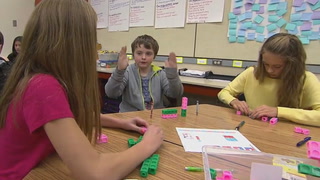
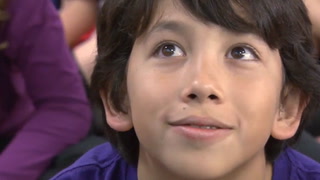
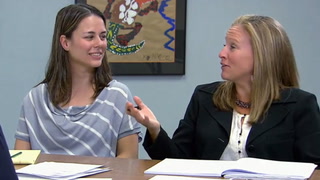


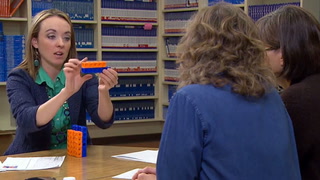
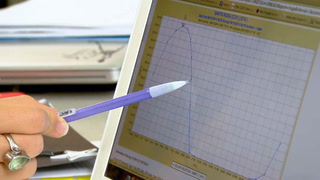
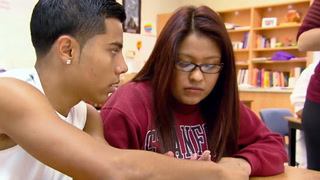
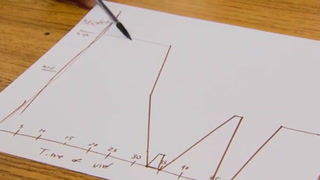
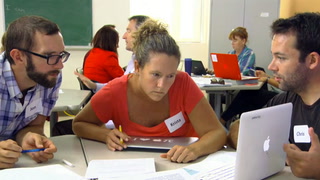









20 Comments
Amy Mullin Aug 31, 2020 10:45am
John Swartzbaugh Jun 20, 2018 1:41pm
Natalie Haynes Nov 30, 2017 1:31am
Robert Leabo Nov 19, 2017 1:39pm
nishija PK Oct 3, 2017 2:42pm